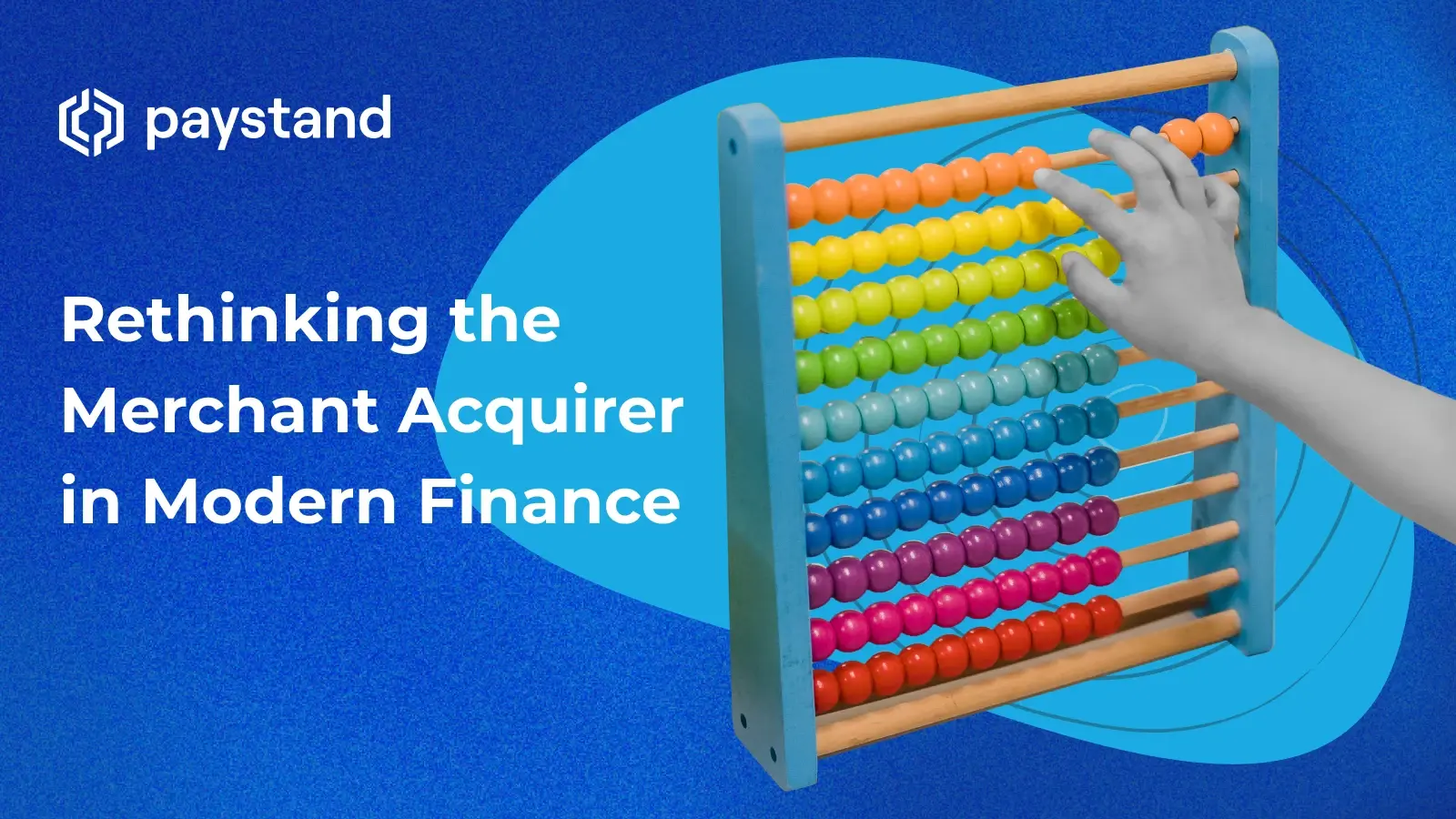Rethinking the Merchant Acquirer in Modern Finance

Table of Contents
- What is a merchant acquirer?
- How does a merchant acquirer work?
- Merchant acquirer vs. payment processor: what’s the difference?
- The hidden cost of acquiring: merchant acquirer pricing and fees
- What to look for in a modern merchant acquirer
- Rethinking merchant acquiring with blockchain and automation
- Why Paystand is the new standard for merchant acquiring
Key Takeaways
- Merchant acquirers are essential for card payment processing, but their outdated systems can undermine operational efficiency and cash flow.
- Traditional acquiring models suffer from opaque fees, slow settlements, and fragmented infrastructures, rendering them incompatible with today's B2B finance needs.
- Finance teams must understand the difference between merchant acquirers and payment processors, evaluating their integration with tech stacks and automation goals.
- Blockchain platforms and zero-fee networks are redefining payment processing by eliminating intermediaries and boosting speed, transparency, and control.
For finance teams navigating an increasingly digital and decentralized economy, merchant acquirers are outsized in how businesses move money. Whether you’re collecting payments online, via card terminals, or through integrated invoicing platforms, a merchant acquirer stands behind the scenes approving transactions, transferring funds, and charging fees, often without much scrutiny. But in a world where operational efficiency and real-time cash flow are now non-negotiable, ignoring how merchant acquiring works and how it’s evolving can quietly drain your bottom line.
While the merchant acquiring industry has been foundational to traditional card-based commerce, it's also riddled with legacy inefficiencies: unclear pricing models, hidden surcharges, long settlement times, and a fragmented patchwork of intermediaries. Businesses, especially those operating in B2B, now face an important decision: continue using outdated systems or explore new payment models that better align with speed, transparency, and cost efficiency.
If you think your current payment infrastructure is just “good enough,” it’s time to challenge that. Merchant acquiring isn't just a technical backend; it's a strategic financial function. Here’s what today’s finance leaders need to understand.
What is a Merchant Acquirer?
A merchant acquirer (also called an acquiring bank or simply “acquirer”) is a financial institution that processes credit and debit card payments on behalf of a merchant. When a customer initiates a payment, by swiping a card or submitting a checkout form online, the merchant acquirer is responsible for routing the transaction through the card networks (like Visa or Mastercard), communicating with the issuing bank, and settling the funds into the merchant’s bank account.
In other words, the acquirer is the merchant’s entry point into the broader payment processor ecosystem. Without an acquirer, a business can’t accept card payments. In most legacy systems, this also means signing up for a merchant account, agreeing to a fee schedule, and enduring long-term contracts.
How Does a Merchant Acquirer Work?
Behind the scenes, a merchant acquirer does more than just "process payments." It:
- Authenticates and authorizes the card transaction
- Communicates with the issuing bank through the card network
- Advances funds to the merchant (often before the issuing bank releases them)
- Assumes risk if the transaction is later disputed or fraudulent
- Manages settlements and reconciliations
This process happens in seconds but is supported by a complex infrastructure involving payment processors, risk engines, fraud detection systems, and fee assessment models. In traditional models, this also means a frustrating maze of service providers, each taking a cut, and each adding latency and complexity.
Forward-looking finance teams are now evaluating how fast their acquirer settles funds, how well the platform integrates with their ERP systems, what digital payment methods are supported, and whether the acquirer enables or inhibits automation.
Merchant Acquirer vs. Payment Processor: What’s the Difference?
While often used interchangeably, merchant acquirers and payment processors serve distinct roles. Think of the payment processor as the courier: it moves transaction data from one place to another. Conversely, the acquirer is the bank taking on financial risk and handling the money.
In many traditional setups, these roles are split between different vendors. However, this separation can create inefficiencies, introduce hidden fees, and delay issue resolution. It also makes it harder to trace errors or delays in the payment cycle.
Some modern platforms, especially in B2B credit card processing, combine these functions or bypass them entirely using next-generation infrastructure like blockchain or zero-fee processing networks.
The Hidden Cost of Acquiring: Merchant Acquirer Pricing and Fees
Acquirer fee structures are notoriously opaque. Beyond standard credit card processing fees, which often range from 1.5% to 3.5% per transaction, acquirers may charge:
- Monthly service fees
- PCI compliance fees
- Gateway or terminal fees
- Batch processing fees
- Chargeback and dispute fees
- Cross-border or currency conversion fees
Add them up, and you might be paying more than you think. Comparing merchant acquirer pricing and fees can uncover shocking disparities between providers, especially for B2B transactions that involve high-value invoices or recurring payments.
Choosing the right merchant acquirer means looking beyond the rate card. It’s about evaluating settlement speed, contract flexibility, integration with your ERP, support for ACH, eCheck, or real-time payments, and most importantly, the ability to eliminate hidden costs over time.
What to Look For in a Modern Merchant Acquirer
If you’re still using a traditional acquirer, or if you’ve never switched, here’s what modern finance leaders prioritize:
- Transparent pricing with no hidden fees
- Real-time settlement or reduced float time
- Native support for digital payments, including ACH, eCheck, and crypto
- Integrated reporting with your financial stack
- Built-in dispute resolution and fraud protection
- Scalability for B2B transactions
- Support for zero-fee processing models
Some top merchant acquirers in today’s market include big names like Chase, Fiserv, and Worldpay. However, many players still operate within legacy frameworks, where change is slow and innovation is more buzzword than action.
Rethinking Merchant Acquiring with Blockchain and Automation
Here’s the truth: merchant acquiring was built for a time when finance moved slowly, when checks and cards reigned supreme, and when accepting a 3% processing fee was simply “the cost of doing business.” That era is over.
Decentralized technologies like blockchain and smart contracts are transforming how companies move money. Zero-fee processing isn’t just possible, it’s already being adopted. AI and automation are streamlining AR and payments workflows, making many traditional acquiring roles redundant.
That’s where Paystand comes in.
Why Paystand Is the New Standard for Merchant Acquiring
Paystand doesn’t just plug into the system: it rewires it. Our platform eliminates unnecessary intermediaries, allowing businesses to bypass traditional acquirers and processors through a blockchain-based B2B payment network.
Instead of paying 2–3% on every transaction, businesses using Paystand gain access to zero-fee processing, real-time payments, and full automation of AR workflows. No more reconciliations, manual postings, or settlement delays.
Paystand’s Smart Lockbox and ERP integrations (including NetSuite, Sage Intacct, and Microsoft Dynamics) empower finance teams to reclaim control of the entire cash cycle. Transactions are no longer opaque black boxes; they’re data-rich, traceable, and programmable.
If your business relies on outdated merchant acquirers, it’s not just inefficient—it’s actively holding you back. The world is shifting toward programmable finance, and early adopters are already reaping the benefits.
You don’t need another payment vendor. You need a financial infrastructure designed for the decentralized, digital future, and Paystand delivers.
If you haven’t moved into the new wave, here's how. It's still your chance to make a difference. Reclaim control of your payments, eliminate fees, and join the financial revolution. Explore our pricing and plans here.






